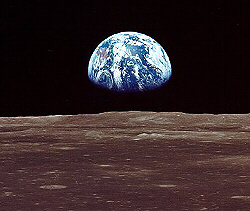

Earth at top and moon at bottom
as seen from Apollo 11
On Thursday, July 24, 1969, the Apollo 11 astronauts were returning from the first manned moon landing and they were getting ready to land in the Pacific Ocean. KYW Newsradio had been "All News" for a little less than four years.
Cut one is about a minute long and takes us from one anchor to the other. Bob Conville, formerly at WPBS, takes over from Don Budd, one of the station's original news anchors. It's 11 am.
Listen in Real Audio!
Listen in Windows Media!
Cut two is 55 and a half minutes long. It starts about 30 seconds before 11:30 am and continues to about 12:25 pm. Art Lane is the station's news anchor. Normally, anchors change every half-hour. However, on this cut, the anchors don't switch until 12:18 pm, after the sports. At that point, Bill Gregory takes over.
Listen in Real Audio!
Listen in Windows Media!
Cut three is 38 and a half minutes long and starts at 12:26 pm. Why is there one minute missing between the end of cut two and the beginning of cut three? That's the point when the tape was flipped over to the other side to continue recording and thus that minute wasn't recorded. This cut features a report by KYW Newsradio's Andrea Mitchell.
Listen in Real Audio!
Listen in Windows Media!
These cuts were mastered off the original tape recorded in 1969. Recorded at 3 and 3/4 ips, it was recorded on low price "Melody" brand recording tape. KYW Newsradio was fed into the left track and another news source fed into the right track. The right track was connected electronically to the tuner source. However, KYW Newsradio was recorded off air with a microphone in front of the speaker. We have equalized and reduced the background noise. However, we could do only so much without removing the teletype ticker (a tape recording) that KYW Newsradio used in the background.
These recording had some severe drop out problems. Actually, it didn't drop the audio to zero but just lowered the level to a just about an inaudible level. We have corrected this by manually raising the level at the drop out point. Most of these corrections were done so that you can't really hear the drop out anymore. The tape also had another problem. Over the years, the tape had warped slightly causing a change in the equalization as the tape passed by the playback head. The original tape sounded like someone was turning the treble-bass knob back and forth. Most of this is at the beginning of cuts two and three. We have again corrected for that. The biggest problem was that sometimes the equalization changed at the point where there was drop out. This too has been fixed. However, there are a few points where it may be noticeable to the trained ear.
This is the best tape (actually the only one known to exist) of this broadcast material. Sometimes we get communications from people asking why we didn't include a certain segment of missing material (like where the tape was turned over). The answer is almost always, "This is all we have." That's why there's material missing between the end of cut one and the beginning of cut two. It simply isn't on the tape.
While we hope that a cleaner copy of this recording will show up in the future, our experience is that as years go by, the number of tapes like this are reduced. People throw them out because they no longer have machines to play them. This is also why "The Broadcast Pioneers of Philadelphia" is doing our DAP, Digital Archival Project. We are transferring these historic recordings from analog tape to a digital format for long term storage.
![]()
From the official archives of the Broadcast Pioneers of Philadelphia
© 2010, Broadcast Pioneers of Philadelphia
All Rights Reserved
The e-mail address of the Broadcast Pioneers of Philadelphia is pioneers@broadcastpioneers.com